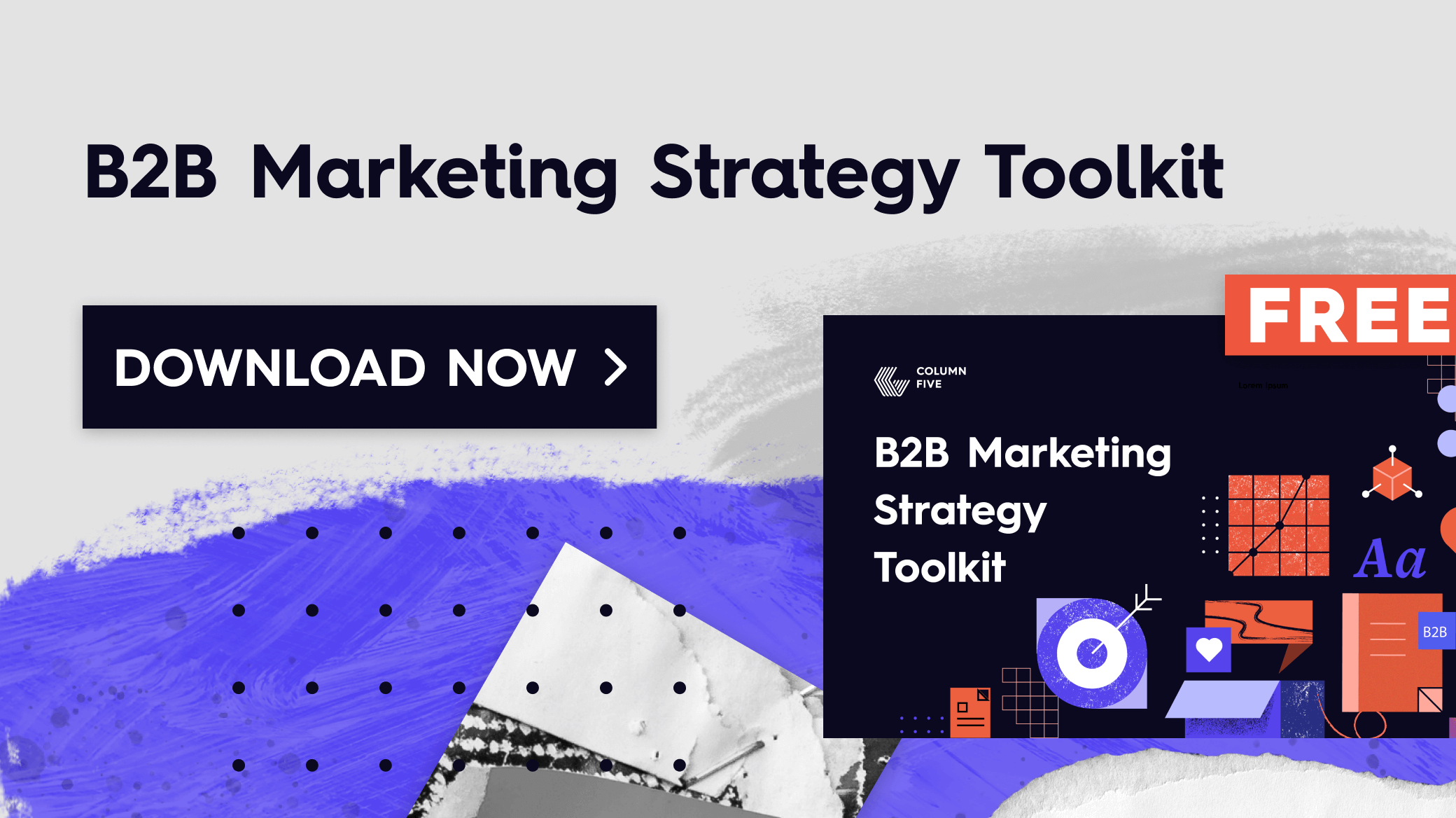Planning for your B2B content strategy can be daunting. You need to create a seamless end-to-end experience through content, deliver the right message at the right time, and deliver that message via the right distribution channels. It’s a tall order. You also need to produce more than one type of content, depending on the stage of your buyer journey, the audience you’re talking to, and what you’re trying to communicate about your brand. Thus, it’s important to understand the five key types of B2B content and how to curate the right mix to achieve your goals.

5 Types of B2B Content for Your Marketing Mix
You might assume all content marketing belongs in the same bucket, but different types of content are better suited to certain goals. Here, we’re covering the five basic types of B2B content, along with our tips to help you use each type to your advantage.
1) Brand Content
What it is: Content about your company (not your product): who you are, your Brand Heart (purpose, vision, mission, values), or brand messaging (tagline, value prop, messaging pillars). Some of this content may be internal-facing only; some may be external. This is valuable content that helps people feel connected to you, aligned with your values, and part of your community.
How to incorporate it into your content mix:
- Showcase your values. People want to know who you are and what you care about. Translate your Brand Heart into content by showcasing the causes you care about, the way you work, etc. (If you haven’t articulated your Brand Heart, start with our free workbook.) For example, Be Good to Each Other is one of our core values. To share this value with our clients, we created a unique holiday gift: a fine art print based on Benjamin’s Franklin’s pay-it-forward philosophy. It was a piece of content that allowed us to share a piece of our brand story with our clients in an unexpected (but much appreciated) way. To see how other brands turn their values into content, check out these inspiring examples.
- Brainstorm ideas around key brand story pillars. If you have your brand messaging framework (tagline, value prop, and key story pillars/selling points), you have great fodder to come up with brand-centric ideas. For example, a series about your manufacturing processes or the ways you bring your mission to life in everyday ways can be great ways to connect with people. If you need brainstorming prompts, here are 7 ways to tell your brand story.
For more inspiration, find out how to tell your brand story through different types of content.
2) Talent Content
What it is: Content about your employer brand, culture, etc. It is geared toward prospective employees, as well as current employees. It’s basically everything people would want to know about what it’s like to work for your company, what your culture is like, who works for you, what life is like behind the scenes, etc. It’s also a way to celebrate and acknowledge those who do work for you.
How to incorporate it into your content mix:
- Showcase your culture. People want to work for brands they respect and align with (especially in the wake of the Pandemic). Your culture is a huge part of an employee’s experience, so creating culture-based content is an important way to communicate what life is like inside your company. (Note: While this is relevant to prospective employees, your customers are also interested in who you are and how you treat people behind closed doors. Being transparent and giving people a peek behind the curtain only cultivates more trust with those consumers.) To do this in unique and creative ways, see our guide to create culture marketing.
- Tell your employer brand story throughout the hiring process. Employer brand content isn’t just a job description and an employee handbook. Find out how to communicate who you are throughout the journey from prospect to new hire, and see how other brands tell their employer brand story through content.
- Turn fellow employees into content creators. This is one of the best ways to give a face and voice to the people behind your brand. Here are 5 ways they can help you generate quality content.
(BTW, if you’re not sure how to tell your employer brand story because, well, there isn’t much to tell, see our guide to build an employer brand you’re proud to share.)
3) Editorial Content
What it is: Content meant to educate, entertain, inspire, or demonstrate your brand expertise or thought leadership to build brand awareness. This can include all types of content, such as articles, guest posts, infographics, podcasts, video, etc. When you think of traditional B2B content marketing, it is usually this type of editorial content.
How to incorporate it into your content mix:
- Focus on value. While brand content is valuable, talking about your brand isn’t always the best way to build brand loyalty. Instead, create content that gives your audience something they need or want, whether it’s tips, tutorials, a unique perspective, an education, or even a laugh. Here are 9 prompts to help you come up with value-centric ideas, as well as the five questions you should ask to vet your ideas.
- Collaborate with a publication. One of the best ways to increase your credibility is to earn placement in a high-profile publication. To increase the likelihood you’ll get that coverage, don’t just create content with an outlet in mind. Reach out and create that content with the outlet. To learn more about this approach, find out how to do publication-tailored content.
- Create data storytelling. Your own data is one of the best ways to come up with unique, original, interesting content ideas. Here’s where to look for internal data, along with our best tips to find the stories in it when you do.
Note: When we do our own content strategy planning, we like to take a look at the content we (as well as our competitors) are producing. This gives us insight into how we might improve our own mix, fill in the gaps, and outshine our competition. To do this yourself, follow our guide to audit your content.
4) Product Content
What it is: Naturally, there is a difference between sales and marketing content. This pillar is for deeper-funnel content, particularly informational content related to your products or services. This includes content about what you do, such as sales materials, demos, explainer videos, informational content, or educational content.
How to incorporate it into your content mix:
- Talk to your sales team. Good content can help your sales team in significant ways, particularly in the time and energy it takes to communicate certain information to prospective (and even current) customers. Find out if there are certain assets that would make the selling process easier or help them enhance the experience for prospective customers. For more tips on this, find out how to create content that empowers your sales team.
- Make it more creative. Contrary to popular belief, not all product content has to be a dull brochure. There are so many ways to share this info in a fun and engaging way, whether it’s through video, infographics, interactives, etc. Look for ways to makeover your existing collateral to make it more effective. For example, a lengthy brochure might become a simple infographic. An onboarding email could become a fun interactive slideshow. If you’re short on inspiration, these examples prove you can be creative no matter how boring your product is.
For more tips to move people along the buyer journey, find out how to bridge marketing and sales in the buyer journey.
5) Performance Content
What it is: Tactical content used to drive a specific KPI, such as landing pages, CTAs, PPC, etc. It’s often supplementary content for campaigns related to other pillars.
How to incorporate it into your content mix:
- Plan early. Sometimes you spend all your time creating a new lead-generating ebook and then quickly slap together a landing page to promote it. But these promotional pieces of content are just as important as their parent piece (e.g., an ebook), so they need just as much attention and, frankly, sometimes even more. Whereas your newest thought leadership article might be 2,000 words, your social ads may boil down to eight perfect words. Treat this content with the same level of investment.
- Refine your messaging. Does your performance content reflect your current voice, branding, and key messaging? Are there areas to improve or opportunities to experiment with different formats, messaging, etc.? Look for ways to test strategically. Start with our tips to write compelling copy, which are especially helpful when you’re a/b testing performance content.
Note: No matter what type of content you create, presenting a cohesive brand identity is crucial to help you stand out. Use our free brand toolkit to design your own identity, and find out how to make sure every piece of content is on-brand.
How to Bring Your B2B Content Strategy to Life
Now that we’ve covered the type of content you can create, you need to decide how to turn your ideas into a successful strategy.
- Revisit buyer’s journey. Identify what people need to hear at each stage to move them along the path to purchase. This will help you identify what messages you’re missing and how you can use a variety of content to deliver them. Use our free template to map your journey (if you haven’t already).
- Curate the right mix. You want to deliver a healthy variety of content to keep people engaged. Find out how to curate the mix and craft a perfectly balanced editorial calendar.
- Optimize your processes. No matter how many good ideas you have, you need the skills and infrastructure to create the actual content. Find out how to improve your own content creation process.
And if you don’t have the bandwidth to do it all yourself, or you need help creating content in one particular pillar, turn to the experts who know how to make this type of content work for you. Follow our tips to find a B2B agency with your expertise, or find out what it’s like to work with us on a content strategy. We’d love to help turn your ideas into A+ content.





